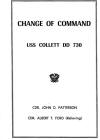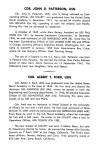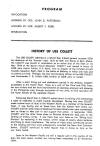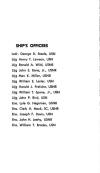



|
USS COLLETT (DD-730) – From FRAM II
to 19 July 1960 by
Bill Brooks The USS COLLETT
(DD-730) was a Bath built Sumner class destroyer commissioned 16 May
1944. COLLETT saw
substantial action in the Pacific through the end of the war earning
six Battle Stars. During
Korea, COLLETT was one of the first destroyers into the conflict and
was part of the “Sitting Duck Squadron” during the invasion at
Inchon. COLLETT served
three tours during the Korean action earning a Navy Unit
Commendation and six battle stars. I reported aboard
COLLETT in the summer of 1959 during a Westpac tour as a newly
minted Ensign. The proud
ship had been used hard since being commissioned on 16 May 1944 and
was tired and in need of a lot of TLC.
COLLETT was chosen as the second ship on the West Coast to go
through the FRAM II modernization program.
The overhaul was started after the first of the year, 1960.
A substantial part of the crew was transferred off with the
remainder staying aboard for the modernization.
A new commanding officer, CDR A.T. Ford, reported aboard.
The changes to the ship during FRAM were substantial.
The old 40mm secondary battery, 21 inch torpedo tubes and
depth charges were all removed.
The deckhouse aft of the bridge disappeared down to the main
deck and was replaced with a new aluminum deckhouse with taller
stacks and a flight deck and hangar for the anticipated DASH
program. One of the big
changes to the ship was the replacement of virtually all of the
electronic gear with new, modern equipment.
Toward the end of the modernization program, we started to
receive new crew members to bring the ship up to complement.
At this time, I was the Communications Officer. On 19 July 1960,
while still attached to the shipyard, COLLETT made preparations to
go to sea for sea trials.
The crew was mostly green and many had never been to sea as a
team. Much of the
equipment was new and unfamiliar.
Many shipyard workers were aboard.
The plan of the day was to leave Long Beach and steam down
toward Seal Beach where the ship was to do one 360 degree turn for
antenna calibration. We
were then to steam out to sea for a full power run to test the
overhauled engineering plant.
I was the Sea Detail CIC officer.
The fog was thick and visibility was poor.
After clearing the breakwater, the Sea Detail was secured and
the underway watch was set.
I was relieved and left CIC to go about my business as
Communications Officer. As the ship built
up steam for the full power run, one radar contact was being plotted
in CIC. As that contact
passed CPA [closest point of approach], we were off Seal Beach and
the planned 360 degree turn was started.
The fog was still very thick.
I was called down to check something out in a space on the
main deck forward on the starboard side.
While in that space I heard a loud grinding noise and was
knocked over. When I
picked myself up and went forward on the main deck, I was shocked to
see the damage. There
was no other ship in sight but it was obvious what had happened.
I was called to the bridge to make sure the proper messages
were sent out. What had happened
was that at about the 270 degree point in our 360 degree turn we had
hit our contact which, when the fog lifted, we determined to be the
USS AMMEN (DD-527). When
we hit her, our bow penetrated the AMMEN’s after fireroom tearing
off COLLETT’s peak tank and leaving it embedded in the AMMEN. COLLETT’s bow was
split in two back to the anchor windlass by AMMEN’s main deck.
The lower half of the bow was crumpled to starboard.
The top of the bow was then almost torn off along with most
of AMMEN’s after deckhouse.
At this time, our starboard (not port) anchor was torn off
and left in the remains of the AMMEN’s deckhouse.
Our upper bow piece was still attached by about three feet of
metal and turned around facing aft. One COLLETT sailor
was in that piece of the bow but was somehow uninjured.
Another COLLETT sailor who was in the bos’n’s locker somehow
was left hanging out over the remains of the bow with his right leg
trapped under the anchor windlass.
That was all that kept him from falling overboard.
Somehow, his only injury was a badly broken leg.
He was COLLETT’s only injured crew member. Later, as the fog
finally lifted, a Marine Corps helicopter arrived with two doctors
to treat the injured.
Because we had a flight deck, the helicopter hovered over it to drop
the doctors off but the flight deck was not large enough for the
aircraft to actually land.
I went out of Radio Central to the deck between the stacks to
watch when the helicopter rotor blades struck a stanchion on top of
the hangar. As the
rotors disintegrated with pieces flying in every direction, the
helicopter crashed on our flight deck.
Somehow, there was no fire and no injuries.
I could hardly believe what I had just seen. We managed to make
it back to port under our own steam, going backwards to avoid
stressing the bulkheads that were exposed to the sea.
The press was all over the disaster.
I want to stress that I have nothing but respect for CDR Ford
and his demeanor throughout all that followed.
He stood up for his crew and personally accepted full
responsibility for the accident. The COLLETT was
inspected and it was determined that the damage could be repaired
and because of the extensive FRAM renovation, she should not be
scrapped. The USS SEAMAN
(DD-791) was a destroyer that was not completed at the end of WWII
and was chosen to be the donor to replace the shattered bow.
The ship was towed down to Long Beach from Seattle where she
had rested since the shipyard workers put down their tools when the
war ended. The two ships
were put into drydock together and the damage was cut off of the
COLLETT. Then the bow
was cut off the SEAMAN and lined up with the front of the COLLETT.
The repair was one continuous weld all the way around the
ship. The rest of the
SEAMAN was then scrapped. The next important
thing that happened was that CDR Robert B. Kitt and LCDR. John G.
Palmer reported aboard as the new CO and XO.
They found a crew that needed to be worked into a team.
These two officers were the best thing that could have
happened to this ship at a really bad time.
COLLETT went on to serve with pride and excellence into the
Vietnam conflict where she saw more action.
She was finally decommissioned in December 1970. The ship saw more
action as the ARA PIEDRA BUENA (D-29) of the Argentine Navy during
the Falklands War.
During that conflict, when the cruiser ARA GENERAL BELGRANO was sunk
by the British submarine HMS CONQUEROR on 2 May 1982, the PIEDRA
BUENA was responsible for rescuing some 400 sailors from the
cruiser. In 1984, the
ship was decommissioned once more and in November 1988 was sunk as a
target during a gunnery exercise.
What a sad end to a proud ship. The events of 19
July 1960 are something I will never forget.
The important thing is that the memory of this ship that
served so well be not be only that of one really bad day.
At the same time, we need to remember the crewmembers of the
AMMEN who were lost or injured on that day. |